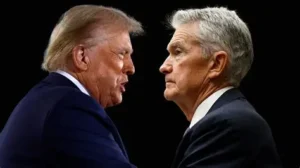The Small Cap Swing Trader Alert Archive
Below you'll find The Small Cap Swing Trader setups stacked up and ordered chronologically.AI Stock Bubble vs Dot-Com Bubble
AI Boom or Bubble? What the Dot-Com Era Teaches Us About Today’s Market
History doesn’t repeat—but as Mark Twain famously noted, it often rhymes.
With the AI stock bubble vs dot-com bubble debate heating up, investors are drawing parallels between today’s tech-driven rally and the speculative excess of the late 1990s. The Nasdaq Composite has surged ahead of the S&P 500 again in 2025, fueled by hopes for artificial intelligence breakthroughs. But the ghosts of the dot-com crash are never far from memory.
So—is this time really different?
Valuations vs. Reality
Back in the dot-com era, it was easy to get swept up in the hype. Hundreds of internet-related IPOs flooded the market in 1999, often with little more than a name and a domain. By comparison, 2025 has seen fewer than 20 generative AI-related IPOs. That scarcity, some argue, reflects more disciplined capital allocation and a genuine focus on profitability.
But the warning signs are still there.
Apollo Global’s chief economist Torsten Sløk warns that today’s top 10 S&P 500 stocks are trading at higher valuations than their 1990s counterparts. At nearly 30 times forward earnings, these giants are priced for perfection. In the early 2000s, those same top-tier names peaked closer to 25 times earnings—just before the crash.
Is This a Bubble?
Not everyone is convinced we’re in bubble territory.
Nicholas Colas of DataTrek Research points to advancements in technology as a key difference. “Computing power has increased 380,000% since 1999,” he notes, suggesting today’s valuations are supported by real productivity gains, not just hype.
Others, like Manish Kabra at Société Générale, argue that it’s not the level of interest rates that matters most, but the direction. With the Fed holding steady and inflation cooling, the conditions that led to a blow-off top in 2000 just aren’t present now. Kabra estimates the S&P 500 would need to rise another 20%—to around 7,500—before valuations enter true bubble territory.
Technical Clues from the Charts
While the broader trend remains bullish, technical signals hint at possible near-term turbulence.
Last week’s S&P 500 chart delivered a rare doji candle, often seen at market turning points. Combine that with a sharp V-shaped breakout above 6100—a pattern with a higher historical failure rate—and the index may be due for a test of the key 6000 level.
In the bond market, the iShares 20+ Year Treasury Bond ETF (TLT) is holding precariously at the $85 level. The formation of a bear flag suggests a break lower could bring a quick move to $82, pressuring equities as yields rise.
Gold’s Quiet Warning?
Gold’s been rallying while few are watching. Since April, it’s traded in a tight range between $3,200 and $3,400. A decisive breakout above resistance could send it to $3,800, hinting at deeper market anxieties.
Ironically, gold—once called “dead money” by critics—is behaving like the smartest asset in the room. Its orderly uptrend and rising sentiment may be a clue that institutional investors are quietly hedging against something bigger.
Final Thought: The Rhymes of Risk
Yes, there are meaningful differences between 2000 and 2025. The Fed isn’t tightening, tech isn’t as frothy, and fewer AI companies are going public. But investor psychology doesn’t change much.
Whether it’s dot-coms or AI, the key lesson is timeless: fundamentals matter, and rallies never last forever.
📊 Stay ahead of the curve. For real-time trade setups, macro analysis, and daily live streams, visit TraderInsight.com.
Trump Powell firing impact on markets
Trump’s Threat to Fire Powell Rattles Markets and Sparks Fears Over Fed Independence
By Adrian Manz
Markets sent a strong signal Wednesday: tampering with Federal Reserve independence comes with consequences.
When President Donald Trump floated the idea of firing Fed Chair Jerome Powell—only to partially walk it back minutes later—investors were rattled. Treasury yields climbed, the U.S. dollar dipped, and stocks briefly faltered as fears of inflation and political interference surged.
The Trump Powell firing impact on markets was swift. The yield on 10-year Treasurys jumped as traders began pricing in the risk of inflationary monetary policy under political influence. Economists warned that undermining the Fed’s autonomy could damage confidence in the U.S. financial system, potentially weakening global trust in both the dollar and Treasury securities.
A Flashpoint in Monetary Policy
Trump’s complaint stemmed from Powell’s refusal to cut interest rates despite the President’s tariff policies and his desire for looser monetary conditions ahead of the 2026 election. Trump suggested Powell could be removed over alleged misconduct tied to the $2.5 billion Fed headquarters renovation, though the central bank strongly denied the claims and released detailed rebuttals.
This wasn’t the first instance of presidential pressure on the Fed, but it may be the most dramatic since the 1970s. Historical examples—like Lyndon Johnson’s browbeating of William McChesney Martin and Richard Nixon’s manipulation of Arthur Burns—underscore how damaging it can be when politics overrides central bank policy.
“Political pressure and, in this case, presidential pressure increases the risk that there will be a pedal-to-the-metal inflationary episode,” warned investment manager Mark Spindel.
Market Moves Reflect Concern
Economists like Thierry Wizman of Macquarie noted the textbook reaction: short-term rates dropped in anticipation of rate cuts, while long-term rates surged on inflation fears. This steepening yield curve suggests markets are bracing for looser policy—even if the price is higher inflation and fiscal instability.
RSM chief economist Joe Brusuelas described the early bond market reaction as “falling off a cliff,” highlighting how sensitive investors are to signs of Fed politicization.
Fed Credibility on the Line
Despite his nomination of Powell, Trump has consistently berated the Fed Chair. With Powell’s term running through May 2026, markets have operated under the assumption that the Fed would remain an independent counterweight to fiscal policy. That assumption may now be in jeopardy.
Former White House adviser Jared Bernstein called the threat “a recipe for disaster,” emphasizing that aggressive rate cuts—especially under political coercion—would violate the Fed’s dual mandate of price stability and maximum employment.
A Bipartisan Flashpoint
Unusually, Powell is now facing criticism from both political camps. Conservative leaders are questioning his stewardship of the headquarters renovation, while progressives like Senator Elizabeth Warren see Trump’s threats as a smokescreen to impose politically driven rate cuts.
Warren stated, “Give me a break…Nobody is fooled by this pretext to fire Chair Powell. And markets will tank if he does.”
What Traders Should Watch
-
Bond Markets: Continued yield curve steepening would signal rising inflation expectations.
-
U.S. Dollar: A weaker dollar may reflect waning confidence in U.S. monetary discipline.
-
Global Markets: Treasury instability ripples worldwide, potentially triggering volatility in equities, commodities, and emerging markets.
As Andy Levin of Dartmouth College noted, Congress technically retains the authority to remove Fed officials “for cause”—but doing so under political pressure could shatter institutional credibility.
Bottom Line
The episode serves as a reminder of the fragile balance between monetary policy and political influence. For investors and traders, the message is clear: don’t underestimate the market-moving impact of challenges to Fed independence.
Even if Powell remains in place, the door has been opened to a new kind of uncertainty—one not driven by data or economic indicators, but by politics.
Tariff-Driven Rally May Be Topping Out
Tariff-Driven Rally May Be Topping Out—Time to Take Profits or Go Short?
Markets have surged in recent months on the back of easing tariff tensions—but that rally may be running out of steam. For active traders and tactical investors, this could be a prime opportunity to lock in gains or consider short positions on stocks that have risen too far, too fast.
The Rally’s Roots: Tariff Reversal and Economic Optimism
Since President Donald Trump softened his stance on key tariffs back on April 8—dubbed “Liberation Day” by traders—the S&P 500 has surged over 25%, buoyed by relief that escalating trade wars would no longer derail the U.S. economy. With tariffs temporarily sidelined, investors shifted focus to fundamentals: tax reform, deregulation, and a streak of strong earnings.
But the relief may be short-lived.
Tariff Risk Returns—and So Does Market Volatility
Trump’s latest tariff threat, slated to take effect August 1, is sparking fresh uncertainty. The Bloomberg Trade Policy Certainty Index spiked to 5.8, the highest since late April. It’s not a panic level (Liberation Day hit over 9), but it’s enough to put markets on edge.
With this backdrop, many traders are asking: Is it time to take profits—or even go short?
Shorting in a Volatile Market: Not for the Faint of Heart
Shorting stocks—betting that a price will fall—is inherently risky. Losses can be unlimited if the stock rises, and borrowing shares comes at a cost. But when a rally appears overstretched, short selling can provide strategic returns.
Wall Street is already flagging potential downside candidates:
Stocks Flashing Red: Names on Multiple Short Lists
Analysts from Wolfe Research, Evercore ISI, and J.P. Morgan have all identified stocks with weak fundamentals, inflated valuations, and bearish sentiment heading into earnings season. Here are 19 names that appeared on at least two “short” lists:
-
Las Vegas Sands (LVS)
-
Texas Pacific Land (TPL)
-
DraftKings (DKNG)
-
Albemarle (ALB)
-
MicroStrategy (MSTR)
-
Tesla (TSLA)
-
Choice Hotels International (CHH)
Key Cases to Watch
Tesla (TSLA)
Tesla’s earnings report on July 23 could be a pivotal moment. Analysts have slashed Q2 expectations by 53%, citing weak EV demand and sliding deliveries. While that lowers the bar, Tesla has missed earnings in six of the last eight quarters and trades at a lofty 132x forward earnings, far above its five-year average.
Choice Hotels (CHH)
This lesser-known name is trading at 18x forward earnings, nearly the same as Wyndham Hotels (WH)—despite projecting slower long-term growth. CHH has a poor track record on earnings surprises, with just two beats in eight quarters, making it vulnerable heading into its next report.
Final Thought: Know When to Walk Away
With tariff uncertainty rising again and several momentum names reaching unsustainable valuations, now may be the time to take profits, reduce exposure, or selectively go short.
Shorting isn’t for everyone, but the most lucrative opportunities often emerge when the crowd is complacent. As always, manage your risk, follow your plan, and trade what’s in front of you.
—
📉 Want real-time analysis and daily trading setups?
Join us in the War Room → TraderInsight.com/live-stream
📰 Catch the daily market recap
Visit: TraderInsight.com/war-room-trading-recap
Chinese Biotech Disruptor Aims at Weight Loss Market
By Adrian Manz | TraderInsight.com
The global weight-loss drug market—dominated by U.S. giants Eli Lilly and Novo Nordisk—is facing a potential shake-up, and traders should take note.
On Tuesday morning, Jiangsu-based Hengrui Pharma and its U.S. partner Kailera Therapeutics announced promising late-stage trial results for their injectable weight-loss drug HRS9531, with average patient weight loss of 18% over 48 weeks, and 19% among trial completers. For context, Lilly’s blockbuster Zepbound (tirzepatide) delivered 21% weight loss in a longer-duration trial. But here’s the catch: Hengrui’s study ended before patients reached a weight loss plateau, and the highest tested dose hasn’t even been evaluated yet.
While this news won’t unseat Zepbound’s market dominance overnight, it signals something far more important for market participants: the rise of Chinese biotech as a competitive global force.
💡 Trading Implications
Here are the key takeaways for active investors and traders:
1. U.S. Biotech May Lose Its Innovation Moat
The weight-loss market is one of the largest and fastest-growing segments in global healthcare. Lilly and Novo have enjoyed outsized valuations fueled by first-mover advantages in GLP-1 therapies. But Hengrui’s data shows that Chinese companies are closing the innovation gap—and fast. Kailera is now preparing to run global trials to pursue broader approvals.
2. Chinese Innovation, American Distribution
Kailera Therapeutics—a U.S.-based company launched just last October with $400 million in private capital—holds exclusive rights outside China to HRS9531. That includes the U.S. market. Interestingly, Kailera’s chief commercial officer is a former brand leader for Zepbound at Lilly, positioning the startup with deep domain experience in the space.
3. GLP-1/GIP Agonist Arms Race
Kailera’s HRS9531 is a dual GLP-1/GIP receptor agonist, just like Zepbound. Earlier trials even showed 22.8% weight loss at higher doses—potentially exceeding Zepbound’s performance. With investors already pricing in sky-high expectations for Lilly and Novo, any credible threat to their IP dominance could shift valuations quickly.
4. Surge in U.S. Licensing Deals
This news comes amid a flurry of recent licensing deals between Chinese biotechs and U.S. pharma giants. Merck paid $112 million up front to license an oral GLP-1 from Hansoh Pharma. Regeneron followed with an $80 million deal. Even legacy players like AstraZeneca are getting in on the action.
💬 The implication? U.S. Big Pharma is increasingly outsourcing innovation to China. The trend could either erode U.S. biotech independence or enhance efficiency and global collaboration.
📊 What Traders Should Watch
-
Eli Lilly (LLY) – Shares fell 3.45% on Tuesday, possibly reacting to the Hengrui trial results and broader profit-taking. Watch for technical support near recent breakout levels.
-
Novo Nordisk (NVO) – Though less directly impacted, increased competitive pressure could weigh on sentiment.
-
Chinese biopharma ETFs – These may start to see inflows if investor sentiment turns toward high-growth Chinese R&D.
-
U.S. small/mid-cap biotech – Could lose out on capital if Big Pharma prioritizes Chinese partnerships.
🧠 Final Word
While HRS9531 is still years away from U.S. approval, this news highlights a paradigm shift. Chinese biotech firms are no longer just contract manufacturers or generic competitors—they’re front-line innovators with the potential to disrupt global markets.
Traders and investors should expect volatility, sector rotation, and opportunity as the global obesity drug war heats up. The question isn’t just who has the best drug today—but who can deliver next-generation therapies tomorrow.
Stay focused. Stay informed. And as always, trade what’s in front of you.
—
🔗 Watch the latest market recap: TraderInsight.com/war-room-trading-recap
🔴 Join our next live session: TraderInsight.com/live-stream




